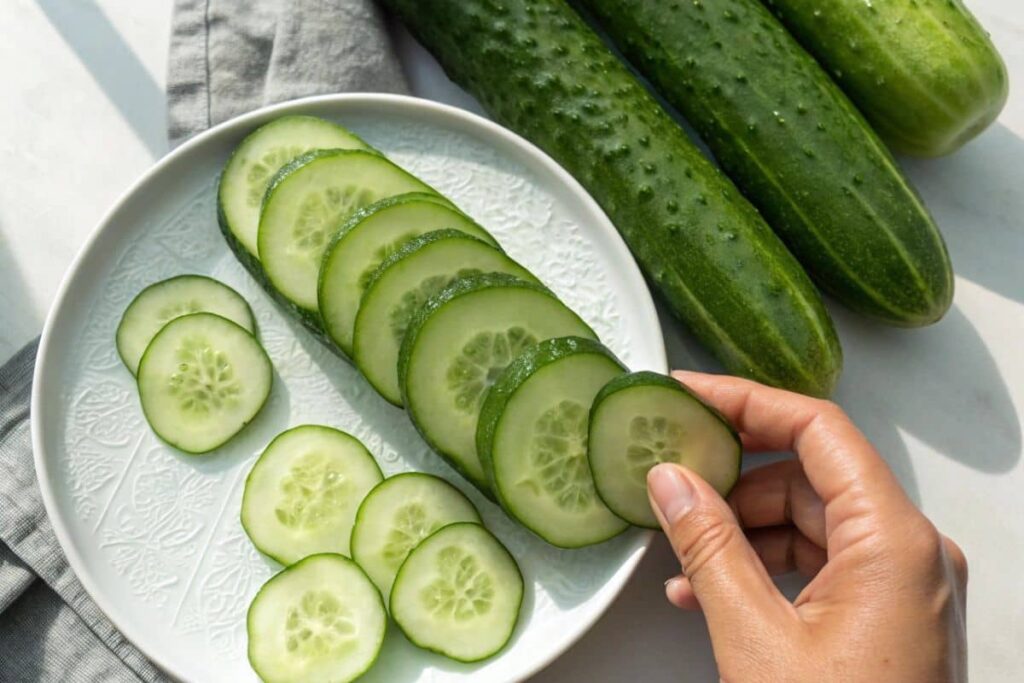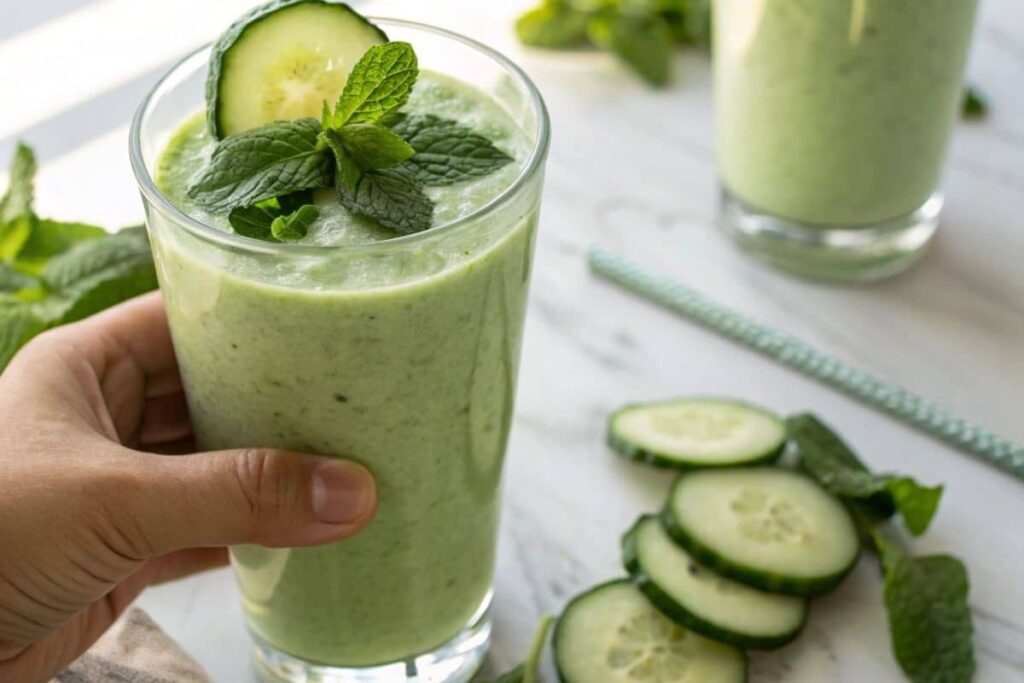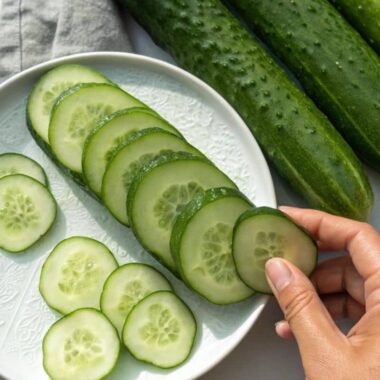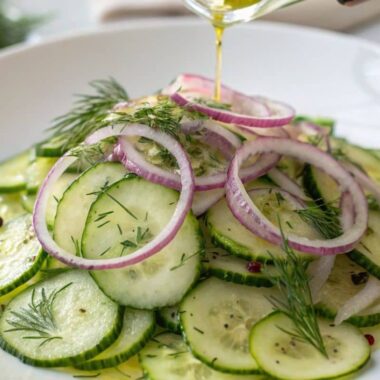Ever wondered about the difference between a cucumber and a Persian cucumber? While they may seem alike at first glance, their unique traits set them apart in size, flavor, and versatility. If you’re curious about which one is best for snacking, cooking, or gardening, this guide will answer all your questions and more.
Table of Contents

Why Compare Cucumbers?
Cucumbers are a staple in many kitchens around the world, but not all cucumbers are created equal. Persian cucumbers, with their unique characteristics, are growing in popularity. So why should you care about the difference? Understanding these distinctions can help you choose the best option for your recipes, your health, and even your gardening adventures.
Overview of Cucumbers: Understanding the Difference Between a Cucumber and a Persian Cucumber
What Are Cucumbers?
Cucumbers are a refreshing and crunchy fruit—yes, fruit—that belong to the gourd family. They’re often used in salads, sandwiches, and even beauty treatments! Packed with water, cucumbers are a great way to stay hydrated while enjoying a crisp bite.
“Cucumbers are like nature’s bottle of water wrapped in a crunchy shell.”
History and Origins of Cucumbers
Cucumbers have been cultivated for thousands of years, originating from South Asia. Over time, they spread to Europe, the Middle East, and beyond. Today, they are a global favorite, showing up in dishes from tzatziki to pickles.
Understanding Persian Cucumbers
What Are Persian Cucumbers?
Persian cucumbers are a specific variety of cucumber known for their small size, thin skin, and sweet flavor. Unlike regular cucumbers, they don’t need to be peeled, making them super convenient for snacking or cooking. Think of them as the “no-drama cucumber.”
Where Do Persian Cucumbers Come From?
As the name suggests, Persian cucumbers have Middle Eastern roots. They thrive in warm climates and are often grown in greenhouses, ensuring a consistent quality all year round.
Fun Fact: Persian cucumbers are sometimes called mini or baby cucumbers in grocery stores.
Key Differences Between Cucumbers and Their Persian Variety
Size and Shape Variations
Let’s start with the most obvious difference—size and shape. Regular cucumbers tend to be much longer, often reaching up to 12 inches, making them ideal for slicing. In contrast, Persian varieties are shorter, measuring only 4 to 6 inches. Their smaller size makes them more convenient for snacking or tossing into salads without cutting them first.
Texture and Skin Differences
Another key difference is the texture of their skin. Larger cucumbers typically have thick, waxy skin that extends their shelf life, but it can be less enjoyable to eat unless peeled. On the other hand, the Persian variety has thin, smooth skin that is completely edible. This means no peeling needed, saving time and effort in the kitchen. Additionally, the thin skin gives them a crispier texture, making them perfect for fresh dishes.
Flavor Profiles: Mild vs. Sweet
When it comes to flavor, the differences become even more apparent. Larger cucumbers tend to have a mild, sometimes watery taste, and they can develop bitterness if they are overripe or grown in poor soil. In contrast, Persian varieties are naturally sweeter and more aromatic, making them a go-to choice for those looking for better flavor.
Seed Content and Edibility
Lastly, there’s a significant difference in seed content. Larger cucumbers often have bigger seeds, which can make the texture less enjoyable and may even require removal for certain recipes. In contrast, Persian types have tiny, soft seeds that are barely noticeable, making them ideal for smoothies, salads, and other fresh dishes where you don’t want seeds to stand out.
Nutritional Comparison
Cucumbers are healthy, no matter the type, but Persian cucumbers have a slight edge in convenience and taste. Let’s break it down:
| Nutritional Component | Regular Cucumbers (per 100g) | Persian Cucumbers (per 100g) |
|---|---|---|
| Calories | 15 | 12 |
| Water Content (%) | 95 | 96 |
| Fiber (g) | 0.5 | 0.7 |
| Vitamin C (%) | 10 | 15 |
| Potassium (mg) | 147 | 180 |
Did you know? Persian cucumbers are slightly more nutrient-dense than regular cucumbers, making them a healthier choice for snacking.
Creative Ways to Use Persian Cucumbers
Persian cucumbers aren’t just for basic salads—they’re versatile and can elevate your meals in unexpected ways. Let’s explore some creative ideas to inspire your next dish. 🌟
1. Pickled Persian Cucumbers
Love pickles? Persian cucumbers are perfect for quick pickling. Their small size and tender skin allow them to soak up brine faster than regular cucumbers. Here’s a simple recipe:
Quick Pickled Persian Cucumbers
- Ingredients:
- 5 Persian cucumbers, sliced
- 1 cup vinegar (white or apple cider)
- 1 cup water
- 1 tbsp sugar
- 1 tsp salt
- 2 garlic cloves, crushed
- Fresh dill (optional)
- Instructions:
- Mix vinegar, water, sugar, and salt in a saucepan and heat until dissolved.
- Place sliced cucumbers and garlic in a jar.
- Pour the brine over the cucumbers, add dill if desired, and refrigerate for 24 hours.
You’ve got tangy, crunchy pickles ready to jazz up your meals! 🥒
2. Persian Cucumber Smoothies
Surprised? Cucumbers are a fantastic addition to smoothies. Persian cucumbers, with their mild sweetness, blend seamlessly into drinks without overpowering other flavors. Try this:
Refreshing Cucumber-Mint Smoothie
- Ingredients:
- 2 Persian cucumbers, chopped
- 1 cup Greek yogurt
- 1 handful of fresh mint leaves
- 1 tbsp honey
- 1/2 cup water or coconut water
- Instructions:
Blend everything until smooth and serve chilled. This smoothie is not just refreshing but also hydrating and packed with nutrients.
“It’s like drinking a spa day in a glass!”

3. Persian Cucumber Sushi Rolls
Take your homemade sushi game to the next level by swapping traditional cucumber slices with Persian cucumbers. Their crunch and sweetness add an exciting twist to the classic roll.
Cucumber Sushi Roll Recipe
- Ingredients:
- 1 Persian cucumber, julienned
- 1 cup cooked sushi rice
- 1 nori sheet
- Your favorite fillings (e.g., avocado, smoked salmon, cream cheese)
- Instructions:
- Spread sushi rice over the nori sheet.
- Add Persian cucumber and other fillings in the center.
- Roll tightly, slice, and enjoy your homemade sushi!
Persian Cucumber vs. English Cucumber
While this article has focused on Persian vs. regular cucumbers, let’s briefly address another contender: English cucumbers. How do Persian cucumbers stack up against this long, seedless variety?
| Feature | Persian Cucumber | English Cucumber |
|---|---|---|
| Size | Short and compact | Long and thin |
| Skin | Thin and smooth | Thin but waxy |
| Flavor | Sweet and crisp | Mild and watery |
| Seeds | Minimal | Almost seedless |
| Uses | Snacking, salads, pickles | Sandwiches, soups |
Cultural Importance of Persian Cucumbers
In Persian and Middle Eastern cuisine, these cucumbers play a starring role. From fresh salads like Shirazi salad to yogurt-based dips like mast-o-khiar, Persian cucumbers are a cornerstone of traditional meals. Their sweetness and crunch complement the tangy, herby flavors of these dishes perfectly.
“Persian cucumbers are more than just food; they’re a cultural icon in Middle Eastern kitchens.”
Growing and Harvesting Differences
Cultivation Practices for Regular Cucumbers
Regular cucumbers require quite a bit of attention in the garden. They thrive in warm climates and need ample space to grow due to their sprawling vines. Typically, they’re grown outdoors in the summer months. However, one common issue? Pests and diseases. Regular cucumbers can be magnets for pests like cucumber beetles and diseases like powdery mildew.
“Growing cucumbers is like babysitting a toddler—they need constant care, attention, and protection!”
Why Persian Cucumbers Are Easier to Grow
These low-maintenance cucumbers are often cultivated in controlled greenhouse environments, protecting them from pests and harsh weather. If you’re considering growing cucumbers at home, this variety is an excellent choice. They are compact, less prone to diseases, and their shorter vines make them ideal for smaller spaces.
Shelf Life and Storage
How to Store Cucumbers Effectively
Larger cucumbers have a waxy coating that helps them last longer, but it can make them feel slippery. To keep them fresh, store them in a cool, dry place or wrap them in a paper towel before placing them in the fridge. However, once cut, they lose their crispness quickly.
Keeping Persian Cucumbers Fresh Longer
Thanks to their thin, unwaxed skin, these cucumbers naturally have a longer shelf life. To maximize freshness, store them in an airtight container or a plastic bag in the refrigerator. Bonus? They don’t get slimy as fast, so you can enjoy them for longer.
Pro Tip: Place Persian cucumbers in a zip-top bag with a paper towel to absorb excess moisture. It’s like giving them a cozy blanket!
Common Problems with Cucumbers
Overripe or Bitter Cucumbers
Have you ever bitten into a cucumber and tasted bitterness? This happens more often with larger varieties, especially if they’re overripe or grown in poor soil conditions. In contrast, Persian cucumbers are less likely to develop bitterness due to their consistent growing conditions and tender skin.
Pest Issues and Solutions
Larger cucumber varieties often battle pests like aphids and cucumber beetles, which can damage the plant and affect fruit quality. Greenhouse-grown Persian cucumbers are less exposed to such problems.
If you’re dealing with pest issues, try natural remedies like neem oil or companion planting with marigolds to keep bugs at bay. These methods help maintain healthy plants without relying on harsh chemicals.
“Think of pests as uninvited dinner guests—they ruin everything unless you kick them out!”
Benefits of Choosing Persian Cucumbers
Lower Maintenance and More Flavor
These cucumbers are like the VIPs of the cucumber world—naturally sweeter, crunchier, and requiring minimal prep. Their thin skin means no peeling, and their tiny seeds make them perfect for juicing or eating raw without any hassle.
Perfect for Snacking and Salads
If you love healthy snacking, this variety is a game-changer. Their compact size fits perfectly in your hand, making them ideal for dipping in hummus or tzatziki. Toss them into salads, add them to wraps, or enjoy them plain—either way, they’re delicious and refreshing.
Frequently Asked Questions (FAQs)
Are Persian Cucumbers Healthier Than Regular Cucumbers?
Yes and no. Both varieties are low in calories, high in water content, and great for hydration. However, Persian cucumbers often have a slight edge due to their higher vitamin C and potassium content. Plus, their thin skin means you can eat them whole, retaining all the nutrients found in the peel.
Can They Be Used in Place of Regular Cucumbers?
Absolutely! These versatile cucumbers can replace larger varieties in most recipes. Keep in mind that Persian cucumbers are smaller and naturally sweeter, so the flavor and texture may differ slightly. For pickles, salads, and smoothies, they often work better due to their minimal seeds and crisp skin.
Why Do Persian Cucumbers Taste Sweeter?
These cucumbers are naturally bred for their sweeter, less watery taste. Unlike some larger cucumbers, which can be bland or bitter, this variety offers a consistent sweetness. Their smaller seeds also contribute to their pleasant, refreshing flavor.
“Think of Persian cucumbers as the dessert version of cucumbers—sweet, satisfying, and easy to eat!”
How Do I Store Persian Cucumbers to Keep Them Fresh?
To maintain their freshness and crunch, store them in the refrigerator inside an airtight container or a plastic bag with a paper towel to absorb excess moisture. This method keeps them crisp for up to 10 days. Avoid washing them before storage, as moisture can accelerate spoilage.
Can You Freeze Persian Cucumbers?
While it’s possible to freeze cucumbers, it’s not always ideal. Freezing can change their texture, making them soft and mushy when thawed. However, if you plan to use them in smoothies or soups, freezing works just fine. Simply slice them into small pieces, lay them on a tray to freeze individually, then transfer them to a freezer-safe bag for long-term storage.
Do Persian Cucumbers Have Seeds?
Yes, but they’re tiny and barely noticeable! Unlike some larger varieties, which have hard seeds that may require removal, Persian cucumber seeds are soft and completely edible. This makes them perfect for juicing, slicing, or eating raw without any extra preparation.
What’s the Best Way to Eat Persian Cucumbers?
They are incredibly versatile and can be eaten raw, pickled, or cooked. Some popular ways to enjoy them include:
- Slicing them into salads.
- Using them as dippers for hummus or tzatziki.
- Adding them to sandwiches or wraps for crunch.
- Infusing water with cucumber slices for a refreshing drink.
Are They More Expensive Than Regular Cucumbers?
These smaller cucumbers can sometimes cost more due to their greenhouse-grown nature and specific growing conditions. However, their superior taste, convenience, and crisp texture often make them a worthwhile choice for those who prioritize quality.
What Makes Them So Popular?
Their appeal comes from their balanced flavor, ease of use, and versatility. With a naturally mild sweetness, edible skin, and soft seeds, they’re perfect for snacking and cooking. Additionally, their longer shelf life and consistent texture make them a preferred option for many.
What Is the Difference Between Persian and English Cucumbers?
Persian and English cucumbers are both thin-skinned and mild in flavor, but they have some differences:
- Size: Persian cucumbers are shorter and more compact.
- Flavor: Persian cucumbers are slightly sweeter.
- Seeds: English cucumbers are almost seedless, while Persian cucumbers have tiny, soft seeds.
- Uses: Persian cucumbers are great for snacking and pickling, while English cucumbers are often used in sandwiches and soups.
Can You Grow Persian Cucumbers at Home?
Yes! they are easy to grow at home, especially in containers or small gardens. They have shorter vines compared to regular cucumbers, making them a great choice for limited spaces. Just make sure they get plenty of sunlight and water regularly for the best results.
Conclusion: Making the Right Choice for Your Kitchen
By now, you’re a cucumber expert! 🥒 Whether you’re a fan of the classic regular cucumber or leaning towards the sweet, crisp Persian cucumber, both options have their merits. Persian cucumbers, with their smaller size, thin skin, and versatile uses, are the perfect addition to any kitchen. They’re great for snacking, salads, and even unique recipes like sushi rolls or quick pickles.
If you’re curious about exploring more food-related topics, why not dive into some of these? Discover the fascinating world of blue cheese, learn about the creamy richness of gouda cheese, or explore comforting meals like the old-fashioned chicken and rice casserole. Wondering if baby cucumbers are Persian? Get all the answers there! And if nutrition interests you, check out the calories in Persian cucumbers or a detailed guide on Persian cucumbers themselves.
No matter what you choose, cucumbers—regular or Persian—are a refreshing and healthy way to enhance your meals. So grab some cucumbers today and start experimenting with delicious new recipes. Your taste buds will thank you!

Quick Pickled Persian Cucumbers
Ingredients
For Pickling
- 5 pieces Persian cucumbers, sliced Choose firm cucumbers for best results.
- 1 cup vinegar (white or apple cider) For a different flavor, experiment with different vinegars.
- 1 cup water
- 1 tablespoon sugar Adjust based on sweetness preference.
- 1 teaspoon salt
- 2 cloves garlic, crushed Can omit if desired.
- to taste Fresh dill (optional) Great for added flavor!
Instructions
Pickling
- Mix vinegar, water, sugar, and salt in a saucepan and heat until dissolved.
- Place sliced cucumbers and garlic in a jar.
- Pour the brine over the cucumbers, add dill if desired, and refrigerate for 24 hours.





